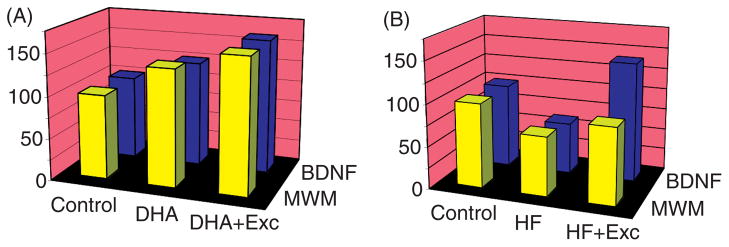Figure 16.

Cartoonish representation that illustrates the interaction between exercise and diet on the regulation of brain plasticity and cognitive function. (A) Based on experimental evidence (73), exercise or a diet rich in the omega-3 fatty acid docosahexaenoic can increase the expression of genes involved in synaptic plasticity and function while a high-saturated fat and sucrose (HF) diet has the opposite effects. Dietary supplementation with omega-3 fatty acids elevates levels of brain-derived neurotrophic factor (BDNF)-mediated synaptic plasticity in the hippocampus, a brain region important for learning and memory. Molecular changes are associated with an enhancement in hippocampal-dependent spatial learning performance in the Morris water maze (MWM). (B) In turn, animals exposed for three weeks to a HF diet showed opposite effects to the omega-3 fatty acid diet on BDNF levels and cognitive capacity. Concomitant exposure of the animals to voluntary running wheel exercise enhanced the effects of the omega-3 fatty acid diet, while counteracted the effects of the HF diet on synaptic markers and cognitive ability. Values are expressed as a percentage of control (regular diet, no exercise). Modified, with permission, from reference (73), p. 575
